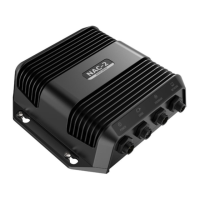Ú
Note: DCT turn pattern is only available if the system has a valid
depth input.
• Turn variables:
- Depth gain. This parameter determines the ratio between
commanded rudder and the deviation from the selected depth
contour. The higher depth gain value the more rudder is
applied. If the value is too small it will take a long time to
compensate for drifting off the set depth contour, and the
autopilot will fail to keep the boat on the selected depth. If the
value is set too high the overshoot will increase and the
steering will be unstable.
- CCA. The CCA is an angle that is added to or subtracted from
the set course. With this parameter you can make the boat yaw
around the reference depth with lazy-s movements. The larger
the CCA the bigger yawing will be allowed. If the CCA is set to
zero there is no S-ing.
- Ref. depth. This is the reference depth for the DCT function.
When DCT is initiated the autopilot reads the current depth
and set this as the reference depth. The reference depth can be
changed when the function is running.
Ú
Note: If depth data is lost during DCT the autopilot will
automatically switch to AUTO mode.
It is recommended to turn ON the AP Depth Data Missing alarm
when using DCT. When this alarm is activated an alarm will be
raised if the depth data is lost during DCT.
28
User settings | NAC-2/NAC-3 Commissioning Manual
Tuning parameters, AP44
Rudder gain
This parameter determines the ratio between commanded rudder
and the heading error. The higher rudder gain value the more
rudder is applied. If the value is too small it will take a long time to
compensate for a heading error, and the autopilot will fail to keep a
steady course. If the value is set too high the overshoot will increase
and the steering will be unstable.
A The value is set too high. Steering becomes unstable and
often the overshoot will increase
B The value is set too low. It will take a long time to
compensate for a heading error, and the autopilot will fail to
keep a steady course
Counter rudder
Counter rudder is the amount of counteracting (opposite) rudder
applied to stop the turn at the end of a major course change. The
settings depend on vessel’s characteristics, inertia, hull shape and
rudder efficiency.
Sea trial | NAC-2/NAC-3 Commissioning Manual
21

